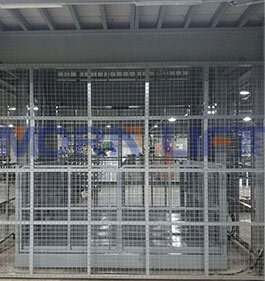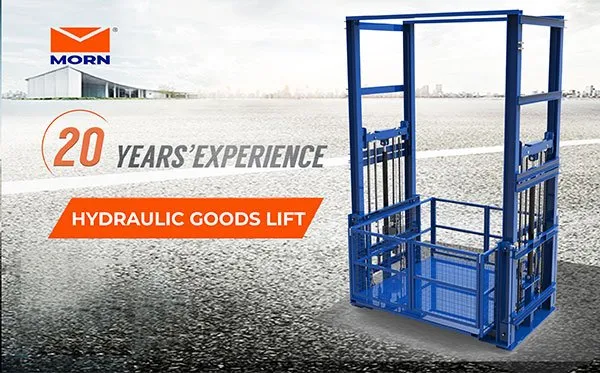As a kind of lifting appliances, MORN hydraulic freight lifts are widely used for handling cargoes or goods between floors of buildings of warehouse, workshop, and factories. Here is something you need to know about the freight lift>> .
Table of Contents
1 What Is Special Equipment
According to the Regulations on Safety Supervision of Special Equipment issued by the State Council, the term “special equipment” in these Regulations means boilers, pressure vessels (including gas cylinders, the same below), pressure pipelines, elevators, lifting appliances, passenger ropeways, large amusement devices, and non-road vehicles, which relate to safety of human lives or have high risks. When producing freight lifts, MORN LIFT employees conduct production in accordance with the provisions of these Regulations and the requirements of the safety technical codes formulated and published by the department of the State Council for safety supervision administration of special equipment.
These Regulations also state that a unit producing special equipment shall assume responsibility for the safety performance and energy efficiency index of the special equipment produced by it, and shall not produce any special equipment that does not conform to the requirement on safety performance or the energy efficiency index, or any special equipment that is declared eliminated in the national industrial policies. Maintaining a safe and healthy environment at work is a top priority for many workplaces which rely on the hard work of both employees and management. When safety procedures and policies are operating effectively, and everyone is working together to minimize risk, the number of incidents in the workplace is greatly reduced.
We carry out freight lift production in strict accordance with safety regulations and provide employees with enough protective equipment to ensure that our employees work in a safe and healthy environment. Generally, MORN LIFT conducts employee education and training every month and informs employees of our working procedure and matters needing attention every morning before employees start to work, thus making it possible that we ensure employee safety and produce high-quality cargo lift.
2 Work-related Accidents in Workplace
According to a 2019 study conducted by the U.S. Bureau of Labor Statistics, approximately 3 million people were injured while at their workplaces. Unfortunately, 5,200 employees succumbed due to work-related accidents in the same year. The safety of employees at work is of great importance; employers should ensure their business adheres to the relevant guidelines that are provided by the Occupational Safety and Health Administration (OSHA). Lifting heavy items is one of the leading causes of injury in the workplace. Strains and sprains from lifting loads improperly or from carrying loads that are either too large or too heavy are common hazards associated with manually moving materials. When employees use hydraulic lifting appliance, they are less likely to suffer from back sprains, muscle pulls, wrist injuries, elbow injuries, spinal injuries, and other injuries caused by lifting heavy objects.
MORN LIFT designs and manufactures freight lift in conformity with national standards. Our inspection and testing department will supervise the manufacturing process and examine finished products in strict accordance with our checklist. Metal detectors will detect unqualified parts or products and inform employee of the flaws to prevent missed inspections. Then the defective parts or unqualified products will be scrapped in case of major problems or repaired in case of minor problems.
In order to ensure the normal operation of the freight lift after production, we will carry out a series of testing and commissioning items to test the performance of the freight lift and detect whether there is any problem on the finished products.
3 Objectives of the Testing & Commissioning Procedures
- The objectives of the T & C procedures are:
a) to verify proper functioning of the equipment after production;
b) to verify that the performance of the finished products meets with the specified design intent through a series of tests and adjustments; and
c) to capture and record performance data of the whole production as the baseline for future operation and maintenance.
All the test results will be recorded by the Director in the appropriate test record forms for future reference.
By doing so, it will ensure our finished products meet the factory requirement.
(2) Testing & Commissioning Procedures of Freight Lift
We usually carry out inspection and functional performance tests on the freight lift after the production according to the following procedures:
a) Cracks or scratches
b) Hydraulic system
c) Safety gear and overspeed governor
d) Control station of the freight lift
e) Automatic control system
f) Lifting speed
g) Noise grade
4 Maintenance of MORN Freight Lift
- Workmanship
a) Repair and replacement will be done in a good workman-like manner. Care will be taken during operations such as torquing, drilling, cutting, and welding that no component of the assembly is damaged or weakened to affect the safe operation of the equipment. Rotating parts will be properly aligned within the manufacturers design tolerances;
b) Where maintenance routines require checking of a specific part or device, it means that the part or device shall be checked to ensure performance and adjustment in accordance with the specifications;
c) Any part or device found not to be in accordance with the specifications will be repaired, replaced, or adjusted immediately;
d) The workshop is equipped with full fire extinguisher to prevent accidents when using any flammable type lubricants. The employees are required to obtain a Hot Work Permit for any cutting, welding or grinding work;
e) Where a defective part or function is identified during performing maintenance checks, tests and/or examinations, it will be immediately adjusted, repaired or replaced;
- Lubrication
a) The primary functions of a lubricant are to:
Reduce friction
Prevent wear
Protect the equipment from corrosion
Control temperature (dissipate heat)
Control contamination (carry contaminants to a filter or sump)
Transmit power (hydraulics)
Provide a fluid seal
b) Matters needing attention during lubrication
1) Parts of the lifting equipment requiring lubrication shall be lubricated at intervals no less than those recommended by the manufacturer. The use of excessive amounts shall be avoided;
2) Rust-preventative compounds such as paint, lubricants, graphite or oil, or similar coatings, shall not be applied unless recommended by the manufacturer;
3) Only lifts equipped with guiding members requiring lubrication shall have guide rails lubricated. Excessive amounts shall be avoided and means shall be provided at the base of the rails to collect the lubricant.
(3) Tips to maintain the hydraulic freight lift
The following 6 steps will help you maintain your hydraulic freight lift for better performance:
a) Make sure there is no debris on the mechanical parts.
b) Check the pressure relief valves, up/down button, limit switches, etc.
c) Check all the snap rings and clips. These should be in a secure position and not in danger of falling out.
d) Next, check for any signs of wear and tear.
e) The hydraulic fittings should contain no cracks or leaks. Make sure nothing is leaking. If you do find a leak, clean up the seepage and see if any more appears after a short operation.
f) Lastly, check the electrical lines and hoses. Make sure the connectors are firmly fixed and the lines and hoses are free of oil stain and dirt.
This is the matters you need to know about MORN hydraulic freight lift, if you have any interest in the product, you can Click Here to fill out the form and contact our sales staff for more information.




